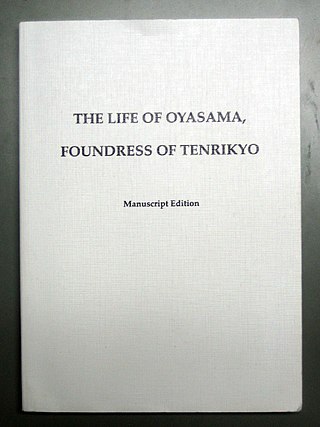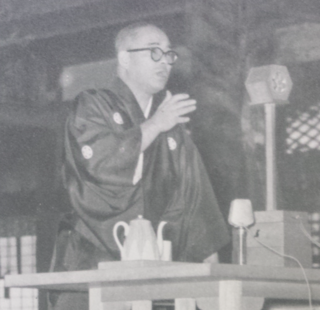Related Research Articles

Tenrikyo is a Japanese new religion which is neither strictly monotheistic nor pantheistic, originating from the teachings of a 19th-century woman named Nakayama Miki, known to her followers as "Oyasama". Followers of Tenrikyo believe that God of Origin, God in Truth, known by several names including "Tsukihi," "Tenri-Ō-no-Mikoto" and "Oyagamisama " revealed divine intent through Miki Nakayama as the Shrine of God and to a lesser extent the roles of the Honseki Izo Iburi and other leaders. Tenrikyo's worldly aim is to teach and promote the Joyous Life, which is cultivated through acts of charity and mindfulness called hinokishin.
The Ofudesaki is the most important scripture in Tenrikyo. It is one of Tenrikyo's three scriptures, along with the Mikagura-uta and the Osashizu. A 17-volume collection of 1,711 waka poems, the Ofudesaki was composed by the foundress of Tenrikyo, Miki Nakayama, from 1869 to 1882.
Nakayama Miki was a nineteenth-century Japanese farmer and religious leader. She is the primary figure of the Japanese new religion Tenrikyo. Followers, who refer to her as Oyasama (おやさま), believe that she was settled as the Shrine of Tsukihi from the moment she experienced a divine revelation in 1838 until her death in 1887.

In the Tenrikyo religion, the Osashizu is a written record of oral revelations given by Izo Iburi. It is one of the three scriptures of Tenrikyo, along with the Ofudesaki and the Mikagura-uta. The full scripture is published in seven volumes and contains around 20,000 "divine directions" delivered between January 4, 1887, and June 9, 1907.
Iburi Izō was the second spiritual leader, Honseki, of Tenrikyo after the death of Nakayama Miki (Oyasama) in 1887, while Oyasama's son Shinnosuke became the administrative leader, the Shinbashira. Having received the "grant of speech" from Oyasama, Iburi dictated the Osashizu, additional divinely inspired instructions on the creation and maintenance of a Tenrikyo community.
In Tenrikyo, God is a single divine being and creator of the entire universe. The first two characters in the Japanese kanji for Tenri-O-no-Mikoto are 天理, where 天 refers to heaven or divinity, and 理 refers to reason or knowledge, thus "Tenri" (天理) refers to divine or heavenly knowledge, and in a sense adds a divine nature to truth itself whereas "天理" also means "natural law" or its pseudonym, "divine law." The English name most frequently used to refer to Tenri-Ō-no-Mikoto outside of ritual is "God the Parent"; in Japanese, the equivalent common name is Oyagamisama. In Tenrikyo, God has no gender.
The Mikagura-uta is one of the three Tenrikyo scriptures, along with the Ofudesaki and the Osashizu. It was composed by the foundress of Tenrikyo, Miki Nakayama, from 1866 to 1875, and revised to its current version in 1882.

Tenrikyo Church Headquarters is the main headquarters of the Tenrikyo religion, located in Tenri, Nara, Japan. This establishment is significant to followers because it is built around the Jiba, the spot where followers believe the god Tenri-O-no-Mikoto conceived humankind.
In the Tenrikyo religion, the Service is the most important prayer ritual, along with the Sazuke. The Service comes in fundamental forms and several variant forms. The text to the Service is the Mikagura-uta, one of the three scriptures of Tenrikyo.
The History of Tenrikyo concerns the social and institutional development of Tenrikyo, from the day the teachings were founded by Miki Nakayama on October 26, 1838, to the present day.
The following is a timeline of the Tenrikyo religion, highlighting significant events since the birth of Tenrikyo's foundress Miki Nakayama. Specific dates are provided in parentheses; the lunar calendar is indicated with ordinal numbers while the Gregorian calendar is indicated with name and number.

The Sazuke refers to a prayer in which a Tenrikyo follower asks for divine intervention to heal an ailment.

The Life of Oyasama, Foundress of Tenrikyo, or The Life of Oyasama, is the biography of Nakayama Miki published and authorized by Tenrikyo Church Headquarters. The Life of Oyasama is one of the supplemental texts to the Tenrikyo scriptures, along with The Doctrine of Tenrikyo and Anecdotes of Oyasama.

The Doctrine of Tenrikyo is the doctrine of the Tenrikyo religion, published and sanctioned by Tenrikyo Church Headquarters. The Doctrine of Tenrikyo is one of the supplemental texts of the Tenrikyo scriptures, along with The Life of Oyasama and Anecdotes of Oyasama.
This article presents a selected bibliography of Tenrikyo, a Japanese new religion.
Tenrikyo theology is the theology of the Tenrikyo religion. The discipline of Tenrikyo theology consists of scriptural studies, historical theology, dogmatic theology, and practical theology.

Nakayama Shōzen was the second Shinbashira of Tenrikyo. He was the first son of Nakayama Shinnosuke, the first Shinbashira, and the great-grandson of Nakayama Miki, the foundress of Tenrikyo.

Nakayama Shinnosuke was the first Shinbashira of Tenrikyo. He was the grandson of Nakayama Miki, the foundress of Tenrikyo.

In the Tenrikyo religion, the Jiba (ぢば) is the axis mundi where adherents believe that God created humankind. The spot is located in the center of the main sanctuary at Tenrikyo Church Headquarters, located in Tenri, Nara, Japan. It is marked by a wooden pillar called the Kanrodai (かんろだい).
In the Tenrikyo religion, Tenrikyo anthropology is the study of humanity and its relationship to God in the context of Tenrikyo theology. This is not to be confused with the social science of anthropology.
References
Citations
- ↑ Tenrikyo Church Headquarters 1993, p. 20.
- ↑ Tenrikyo Church Headquarters 1993, pp. 20–2.
- ↑ Tenrikyo Church Headquarters 1993, p. 22.
- ↑ Tenrikyo Church Headquarters 1993, p. 23.
- 1 2 Matsumura 1998, p. 363.
- ↑ Matsumura 1998, pp. 360–2.
- ↑ Nakayama 1957, p. 12.
- ↑ Nakayama 1957, pp. 157–8.
- ↑ Tenrikyo Church Headquarters 1996, p. 117.
- ↑ Inoue 1998, p. 338.
Bibliography
- Inoue, Akio (1998). "On the Significance of Interdisciplinary Studies of Moto-no-Ri". Women and Religion. Tenri International Symposium '98. The Center for Women and Religion, Graduate Theological Union, Berkeley: Tenri Yamato Culture Congress. pp. 335–339.
- Matsumura, Kazuo (1998). "The Koki Story and the Femininity of the Foundress of Tenrikyo". Women and Religion. Tenri International Symposium '98. The Center for Women and Religion, Graduate Theological Union, Berkeley: Tenri Yamato Culture Congress. pp. 359–397.
- Nakayama, Shōzen (1957). Kōki no kenkyūこふきの研究[Study on kōki] (in Japanese). Tenri, Japan: Tenrikyo Doyusha.
- Tenrikyo Church Headquarters (1993). The Doctrine of Tenrikyo. Tenrikyo Church Headquarters.
- Tenrikyo Church Headquarters (1996). The Life of Oyasama, Foundress of Tenrikyo. Tenrikyo Church Headquarters.